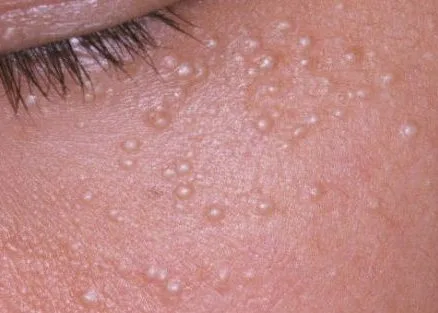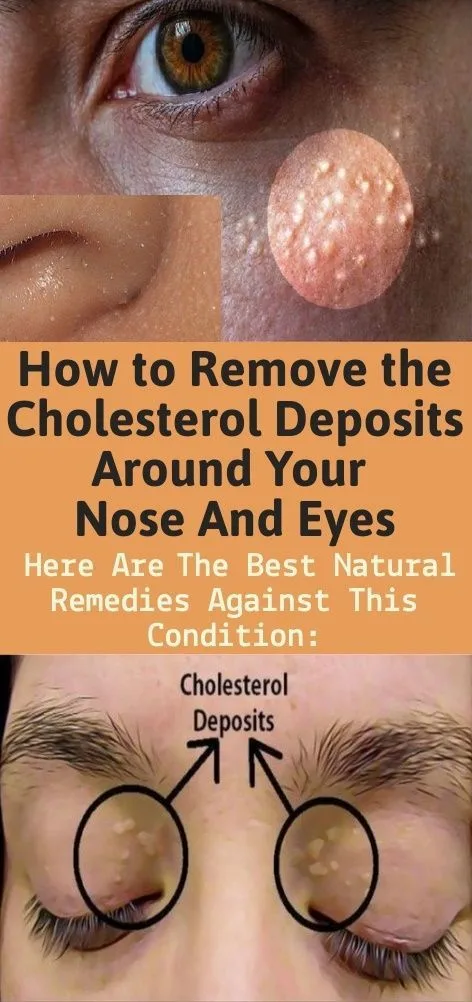Well, milia is not a cholesterol deposit. However, it is an early sign that you need to take care of your health and skin more. Milia- unlike pimples that have flesh and can be squeezed. Usually, cholesterol seeds grow under the eyes and around them. However, it can also grow in other areas such as elbows, knees, hand joints, tendons, and buttocks. If left untreated, the face would look dull. Overall, it affects a person’s beauty. This problem can affect anyone regardless of infants, children, or adults regardless of gender.
Cholesterol seeds this could happen due to:
- Poor diet
- Age
- Drinking
- Genetics

What is Xanthelasma?
Xanthelasma is a skin condition that causes cholesterol deposits to build up under the skin. This leads to the formation of yellow growth on or by the corners of the eyelids or next to the nose. Adults who suffer from high cholesterol, heart disease, heart attack, and atherosclerosis are more likely to get xanthelasma. It is estimated that about 1% of people have xanthelasma. The symptoms of this condition may include flat bumps of yellow color, soft or firm bumps, and an uncomfortable feeling. Moreover, possible causes for xanthelasma include high cholesterol inherited from parents, diabetes mellitus, weight gain, thyroid issues such as hypothyroidism, inflammation, and drinking too much alcohol.
Cholesterol Deposits
- Known as xanthomas, they are yellowish bumps or plaques that form under the skin when cholesterol builds up
- This can be a sign of high cholesterol levels or other lipid disorders
- Most common on eyelids (xanthelasma) but can occur anywhere
- Can range from small, flat lesions to large, raised bumps that join together
- Usually harmless but may be removed for cosmetic reasons or to treat underlying condition

What is Milia?
Milia is a common skin condition. This condition causes small white bumps or cysts under the surface of the skin. About 40% to 50% of newborns in the U.S. have milia. These bumps or cysts are filled pockets under the surface of the skin, most commonly on the face. This skin condition is harmless, but it can affect the appearance. Milia are most commonly occurring in infants, but milia appear in anyone at any age. It also can appear later during infancy among premature babies. The symptoms of this condition may include white to yellow skin, bumps that can appear in groups or clusters, and asymptomatic bumps (don’t cause pain or discomfort). Moreover, this condition is caused by trapped dead skin, damage to the skin from an injury or sun exposure, long-term use of steroid creams or ointments, genetic factors, and autoimmune response.
Milia
- Tiny white bumps or cysts that form when keratin is trapped under the skin surface
- Very common in newborns (neonatal milia), resolving in a few weeks
- In adults, often occurs on the cheeks, nose, and eyelids due to sun damage, skin injury, or certain skin conditions
- Usually 1-2mm in size; may be solitary or multiple
- Generally harmless and resolves spontaneously within months
- Sometimes removed for cosmetic reasons if persistent

Similarities
- Both appear as bumps/lesions around the eyelids and face
- Both can be removed for cosmetic reasons if persistent
- These conditions can have a genetic influence.
- Both can be diagnosed through physical examination.
- They are treated through topical medications and surgeries.
Dissimilarities
- Cholesterol deposits (xanthelasma) are yellowish plaques caused by high cholesterol levels. Milia are tiny white cysts filled with keratin trapped under the skin
- Cholesterol deposits indicate an underlying lipid disorder while the cause of milia is unclear.
- Cholesterol deposits are often soft and larger, while milia are firm and very small (1-2mm).
- Milia are very common in newborns and often resolve spontaneously; cholesterol deposits occur in adults
- Treatment for cholesterol deposits involves managing the underlying condition, while milia may resolve with skin creams or procedures.

In Summary
while both conditions manifest as lesions around the eyes and face, cholesterol deposits are indicative of systemic issues like high cholesterol while milia are localized benign cysts that tend to appear in newborns and often resolve on their own. Their appearance causes, and treatments differ significantly.
- Gujarat Police Logo - January 25, 2024
- CSC Logo - January 25, 2024
- Lata Shabd Roop - January 25, 2024




